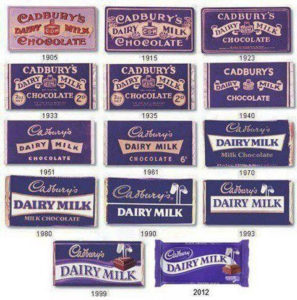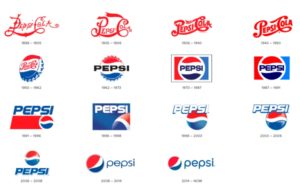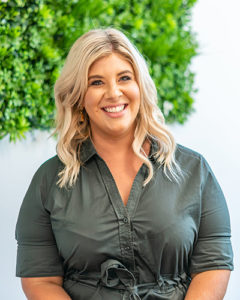Ellie Bakker, Founder and CEO, Splice Marketing
Close your eyes and imagine a bar of Cadbury’s Dairy Milk. What elements come to mind? Beyond the chocolate itself, you might think of the iconic purple wrapper, the cursive ‘Cadbury’ script or the glass and a half of milk symbol.
Dairy Milk was first launched in 1906 with pink packaging (the purple didn’t come until 1920). At that time, Cadbury’s logo was an image of a stylised cocoa tree (William Cadbury’s cursive signature wasn’t stamped on the chocolate until 1921 and wasn’t used on packaging until even later).
As for messaging, Cadbury has emphasised quality, generosity, goodness and enjoyment. It’s messaging includes statements such as ‘There’s a glass and a half of milk in every one,’ ‘Unwrap joy’ and ‘There’s goodness in everyone’. From time to time, it adapts those messages for a particular campaign – such as it’s ‘Cheer and a Half’ campaign promoting its sponsorship of the 2023 FIFA Women’s World Cup. As you can see, there’s a consistent brand message but there’s also innovative ways of conveying it to maintain currency. And it most certainly creates an emotional connection.

Why am I talking about Dairy Milk? Because it’s a familiar brand with a long history. And it’s a great example of a refreshed brand that’s managed to stay relevant and contemporary. In fact, its branding is so wildly successful that about a million bars of Dairy Milk are sold every single day. (The chocolate stash at the Splice office accounts for only about a third of those sales!)
A recap on branding
Branding is a deliberate process that creates a clear and distinct identity for your practice, one that reflects your business values, connects with your intended audience and is memorable.
A brand encompasses everything you communicate in both words and images. It’s about your organisation’s personality, as well as its products and services. It’s about the relationship you have with your patients, referrers or clients who trust you to deliver a quality experience consistently.
The language you choose elicits a response from your ideal customer – it engages their emotions and values to create a sense of connection. If your brand is all about fun, you might choose to sound flirtatious and cheeky. If you wish to be seen as more substantial, you’ll probably choose more professional language.
That’s why messaging forms a key part of your brand’s identity and expression. Take Subway. It’s basically another fast food joint with quick service at formica tables. But its succinct slogan, ‘Eat fresh’, sets it apart from its ‘Finger lickin’ good’ competitors. At Subway, you can have both a quick lunch and a healthy one.
Without this deliberate, creative, ongoing brand identity, any business can find it hard to stand out from the competition. It leaves potential clients (or patients) feeling like they could choose any one of several similar practices and have exactly the same or a better experience. There’s nothing that makes them really want you. You’ve failed to capture the interest and build rapport with your intended audience.
That’s why brand strategy is a core part of most business plans.
What is a brand refresh?
If your brand strategy is still working well but your messaging or visual brand elements (logo, styles and colour palette) seem dated when compared to the competition, then a refresh may be just what you need.
A brand refresh means modernising your image but remaining recognisable – much like a good makeover. A refresh stays true to your practice’s existing brand values but updates the way you express them.
It might mean:
- Updating your logo and palette colours
- Tweaking your existing designs
- Changing your fonts
- Finding better words to express what you do and how you do it
- Ensuring brand guidelines are consistently followed across all platforms.
Here’s how Pepsi did it.

What about updating your messaging? Let’s stick with our food and beverage theme and take a look at Taco Bell. This American-Mexican fast food company has been going since the ‘60s and did well as an alternative to burger joints. In the naughties, though, it began to lose market share.
Research into the reasons for this showed that younger Americans viewed food differently. For them, food wasn’t primarily about fuel. They weren’t looking for a quick bite to eat – they were looking for an experience that could be savoured and shared.
Taco Bell tapped into this mindset and began to express itself as a lifestyle brand on its website and in its edgy social media posts. It drew on its history and encouraged its followers to Live Más (live more).
While most people will be able to tell you their favourite menu item, a lot of folks don’t know we’ve been around for a long, long time. The sixties to be exact. Never heard of them? Ask your folks. Back in ‘62 in Southern California, our courageous Taco Godfather, Glen Bell had a dream.
This dream saw the introduction of food you could hold in your hands, and in your heart. Food that was as much about what’s in it, as who’s around you when you’re enjoying it. And so, Taco Bell became a global sensation, symbolising a movement of agile, trailblazing individuals unafraid to Live Más.
Are you ready to Taco?
Its targeted audience (young people) related so well to messages like the one above that Taco Bell’s sales shot up by 13%, eclipsing the 4% goal originally set. Clearly, what you say matters.
How is a brand refresh different to a rebrand?
In a brand refresh, you’re essentially offering the same products or services but in a different way or to a changing audience. To maintain your connection with your clients or to create a new connection with a new audience, you need to refresh the look, feel and voice of your brand, just like Taco Bell, Cadbury and Pepsi have done.
Depending on the scale of the task, you may need to create buyer personas, express yourself through new messaging or change the visual elements of your brand.
A rebrand is a much greater transformation of your identity. Take Play-Doh. In the 1930s, this clay was a household cleaner that removed coal residue from wallpaper. Sales dropped when households switched from coal fireplaces to oil and gas heaters. Play-Doh rebranded in the 1950s after hearing about a teacher who used the clay for arts and crafts. It’s now a household name – pretty much every family, kindy and primary school has some Play-Doh.
Why (and when to) refresh your brand?
Reasons for a brand refresh include:
- Remaining relevant and contemporary
- Reflecting changes or growth in your practice
- Creating more emotional appeal that resonates with your audience – often requiring a change of tone or up-to-date language.
As for when to refresh your brand, ask yourself:
- Is our look still a good reflection of who we are as a practice?
- How do we look compared to other similar businesses?
- Are we finding it hard to recruit outstanding staff?
- Are we losing patients to competitors?
- Do I feel bored with our look?
- Does our messaging properly express what we do and connect with our audience?
- Is our branding inconsistent in its look and feel?
- Is it time to replace our practice signage, uniforms, or do we need to rebuild our website?
These questions can help you consider if it might be a good time for a brand refresh.
Revitalise your healthcare business
Done well, a brand refresh can be the catalyst that reignites your healthcare business, allowing it to stand out in a competitive market.
As part of the process, you (and your team) reflect on why you do what you do, who your work benefits and what values are important to you. That clarity paired with a fresh new look and revitalised messaging can help reinvigorate your practice, connect with your intended audience and deliver more patients or clients so that you can grow your business to the next level.
So, are you ready to take the first step towards breathing new life into your healthcare brand?
Ellie Bakker is a multi-award-winning entrepreneur and CEO of Splice Marketing, whose strategic business and marketing advice has helped numerous healthcare businesses to extend their footprint to better serve their clientele.




